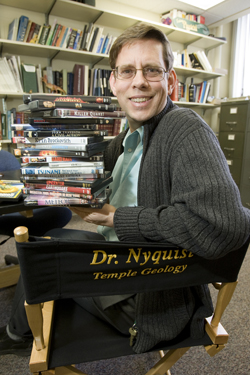Nyquist looks at the science behind Hollywood’s disasters
Provost’s Award for Innovative Teaching in General Education
| The bookshelves in most professors’ offices are jammed with textbooks, reference books, guides and professional journals. But one large section of bookshelf in the office of Earth and Environmental Science’s Jonathan Nyquist contains more than two dozen Hollywood disaster movies.
The movies are the cornerstone of Nyquist’s General Education course, “Disasters: Geology vs. Hollywood,” which uses clips from these movies to teach science to non-science students. For developing the course, Nyquist, the Weeks Chair in Environmental Geology in the College of Science and Technology, is being honored with an inaugural Provost’s Award for Innovative Teaching in General Education. While teaching a core curriculum class in catastrophic geology for non-science majors a few years ago, he conceived and developed “Disasters: Geology vs. Hollywood” for the new GenEd curriculum. The course had its genesis in a similar course being taught by Penn State geoscientist Kevin Furlong. “When the GenEd curriculum was announced, I was kicking around some ideas,” said Nyquist, who joined Temple in 1997 from the Oak Ridge National Laboratory. “I was looking for a new hook on the catastrophic geology class, something that would be of more interest to non-science majors.” |
 Photo by Joseph V. Labolito/Temple University
Nyquist
|
|
|
|
|
Nyquist sat in on Furlong’s class, returning to Temple with concepts he liked and didn’t like, and began building his version of the course. Nyquist has broken each class into three key segments: a 20-minute “mini” lecture, one or more film clips from the Hollywood disaster movies and an activity to emphasize the science behind what those clips portrayed. “The class is not about the movies,” he said. “I will show a few film clips to liven up the class again after my ‘mini’ lecture. Then following the clips, I always have some type of class activity.” Nyquist strongly believes that an active learning experience is critical for learning science. Since the class has no lab, he plans these activities — usually breaking the students into groups — where they often try to answer a scientific question posed by the clips, such as could this disaster actually happen the way it is portrayed in the film? He points to an exercise based on a clip from the film Magma in which lava sweeping through downtown Los Angeles is stopped using concrete road barricades, fire trucks and water-dropping helicopters. The students are challenged to determine if that method would work, and if so, how much water and how many helicopters would be needed. “What I try to get across to my students is science doesn’t just pose questions, it can actually quantitatively try to answer them,” said Nyquist. “When people first hear about this class, they think it is going to be a bunch of movies and pander to students who are afraid of science. But these students get the same science content and quizzes as when I taught the catastrophic geology course.” Nyquist also requires a final project, in which the students make a connection between the class and their major. He has had film majors make their own short movies, music majors write songs, an art student study the effect of acid rain of statues and even a glassblowing major who created art work using volcanic rock. “I have really been encouraged by the students’ enthusiasm for the class,” he said. “That helps me feel better about teaching, and I look forward to going to this class.” |